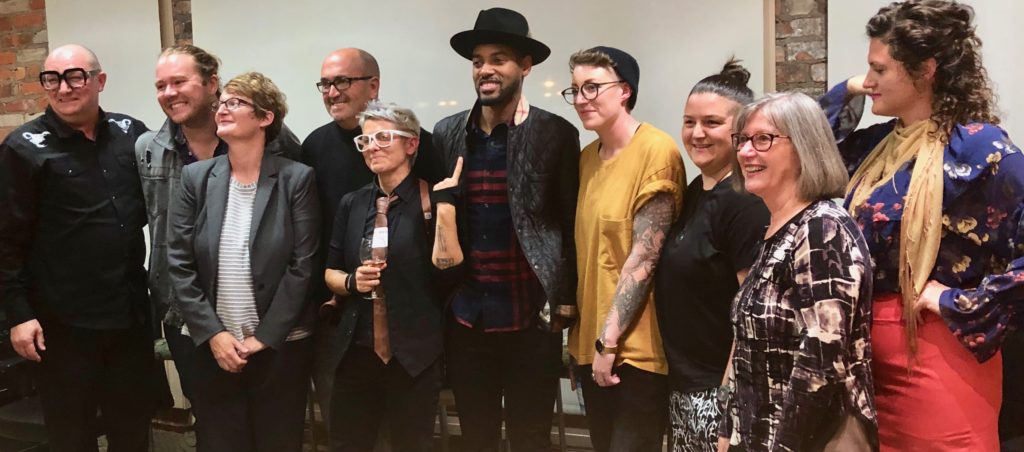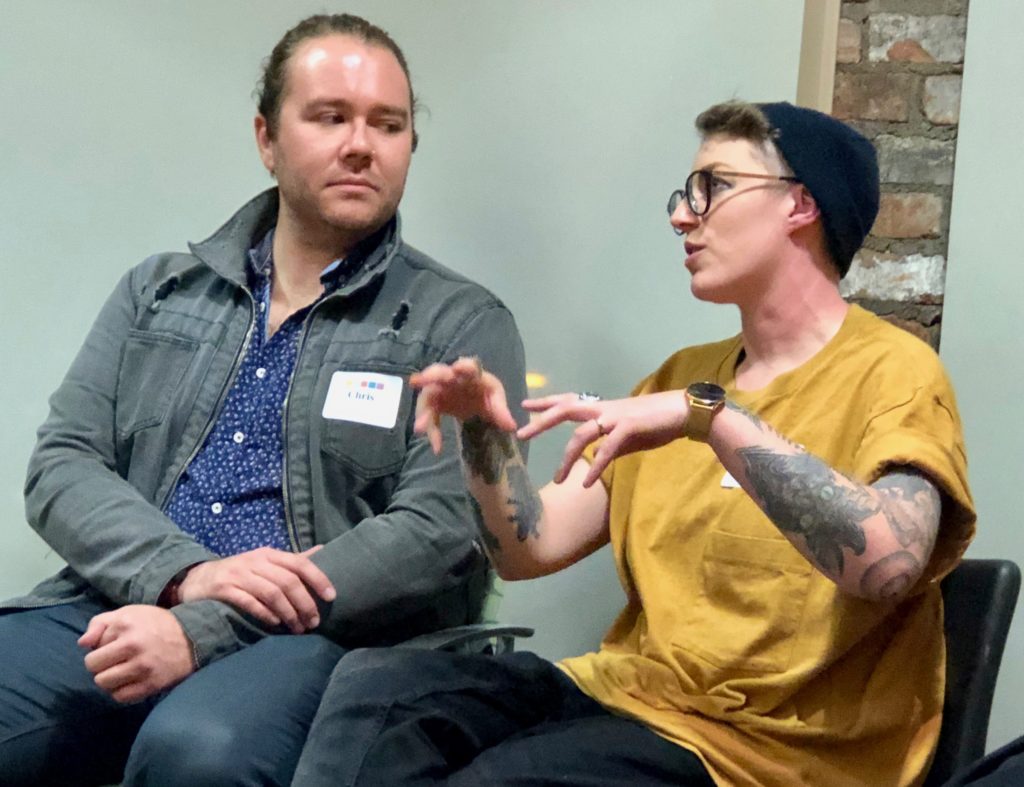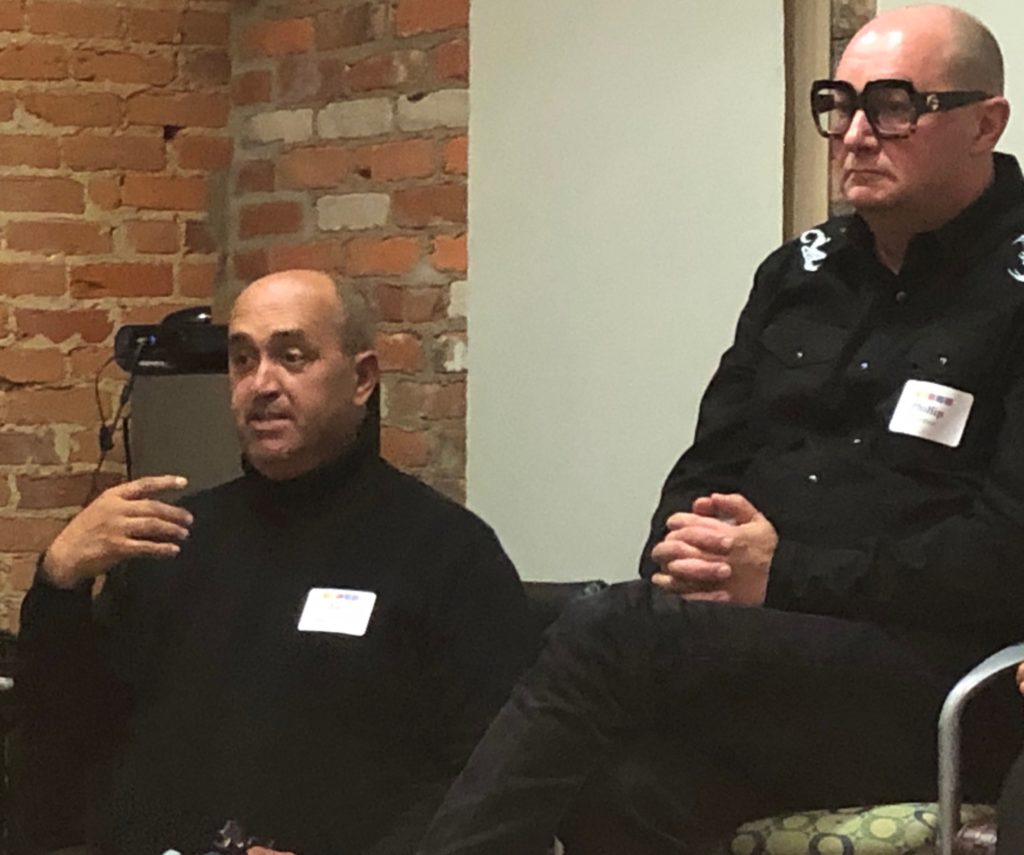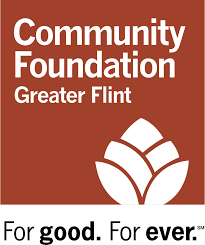By Jan Worth-Nelson
A conversation about the Flint Public Art Project (FPAP) murals in Flint Wednesday night at the Community Foundation of Greater Flint (CFGF) was a celebration of the city as experienced by outside artists.
It also was a conversation among the panelists, all of whom are gay, about the responsibility to create safe space for LGBTQA+ people, not co-opting a culture for profit, and acknowledging that speaking “out of privilege” sometimes leaves out other voices.
Sometimes, in short, social justice activist and UM – Flint lecturer Philip Barnhart said, that means, “Stop colonizing space and shut the f–k up.”
Barnhart, of Flint, is a cultural theorist and program manager of the Michigan Coalition to End Sexual Violence. He also is Flint Public Art Project Executive Director Joe Schipani’s husband.
LGBTQA+ stands for lesbian, gay, bisexual, transgender, queer, asexual and allies.
The discussion was part of a week-long “Free City Mural Festival” sponsored by the FPAP, which has combined the work of hometown street artists and dozens of national and international muralists to create 80-plus murals in the city so far. The goal, FPAP officials say, is 100 murals by 2020.
The festival culminates with a “big reveal” of some of the newest murals and a party from 11 a.m. to 6 p.m. Saturday on Saginaw Street between Atherton and Hemphill roads. The event will include live music and food.
“We love this work,” Community Foundation President and C.E.O. Isaiah Oliver said in welcoming the muralists and FPAP representatives. The foundation contributed support to the mural festival and also has launched a Pride Fund in support of the LGBTQA+ community.
Panelists included Barnhart; Schipani; Zippy Downing, producer and curator of Los Angeles-based CoLabs, an arts organization which creates socially and environmentally conscious installations and content to share around the country; Chris McGeorge, an arts scholar and Michigan native now of LA, where he recently joined Wild Blue Studios, a collective of animators, as a project manager; and Nomad Clan members Joy Gilleard and Hayley Garner, muralists from the north of England whose work has been acknowledged among other places in significant mural texts.
Kady Yellow, who emerged out of the street art and graffiti scene in New York, was moderator. Yellow has helped manage mural projects around the country and came to Flint in August at the request of Schipani, she said.

Muralists and Flint Public Art Project leaders at the Community Foundation of Greater Flint Wednesday night: from left, social justice activist and UM – Flint lecturer Philip Barnhart, Chris McGeorge, CFGF Vice President of Community Impact Sue Peters, FPAP Executive Director Joe Schipani, Zippy from CoLabs, CFGF President and CEO Isaiah Oliver, Nomad Clan Joy Gilleard and Hayley Garner, Sandra Murphy of the CFGF, Kady Yellow (Photo by Jan Worth-Nelson)
Asked by Yellow to describe why she keeps coming back to Flint–five or six times over the past three years, Zippy (she rarely uses her last name) said she is drawn to Flint because of the people and the support invariably offered.
“Forget what you thought about Flint before”
“It’s just very, very open, very welcoming,” Zippy said. “A mural can get lost in a place like Los Angeles or New York City. But when muralists come to paint in Flint, people come up and talk to them, they really show an interest.”
Further, she said, she has come to love the “natural beauty” of the city.
“Forget what you thought about Flint before, and just look at how beautiful Flint can be,” she said. “Just look at these people. I’ve never felt so welcome — and not just because we’re all gay.
“Each time I come back it feels like the family — the Flint family just grows and every time we come here we get exposed to new places.”
This visit she discovered The Golden Leaf, a legendary blues club on Harrison Street. “We shut it down,” she said.
Totem Books on Court Street also got plaudits from several of the artists. “It’s a special place, a very safe place-the first centralized place for the project,” Zippy said.
Art in Flint is “not just a passing interest”

Nomad Clan’s Joy Gilleard (right) with Chris McGeorge (Photo by Jan Worth-Nelson)
Chris McGeorge, a Michigan native now of Los Angeles, agreed about Flint as a safe and comforting space, noting the importance of being careful about how space is carved out of a position of privilege and also noting the significance of relationships between art and local communities and how art can create identities for under-represented people.
“Every time we come back, everyone is so welcoming and so excited about what’s going on” McGeorge said, “It’s not just a passing interest–you build relationships and you get to see art having an impact.”
Flint a “case study in commodifying trauma”
Turning to a different aspect of how art is represented, Barnhart asked the group to “acknowledge the obvious,” pointing out all the panel members were gay, cisgender people and all white. (Cisgender means a person whose sense of personal identity and gender corresponds with their birth sex; in other words, no one on the panel was transgender.)
“That narrative and conversation is problematic,” Barnhart said. He urged a consideration of how power operates and how it affects communities.

FPAP Executive Director Joe Schipani (left) with Philip Barnhart (Photo by Jan Worth-Nelson)
“To look at power, we have to look at money. Where the money goes is where the power is. That needs to be acknowledged,” he said. Sometimes it means culture is co-opted in the name of money, he said.
“Some of us in here know what it means to have been resold, repackaged–and somebody else is making money from it. Every sort of thing can be co-opted and put into a corporate mechanism in which somebody is making the money and controlling the narrative.
“Often that’s not the people who are experiencing the trauma,” he noted, adding, “Flint is the case study of how the world can commodify trauma and make money off it. Part of representation has to be a resistance to that narrative, and this [the group on the panel] is not an ideal representation.”
“Don’t make LGBTQA+ a Disneyland”
“I come from deep privilege,” he said. “I mean I come from privilege based on my cisgender, my maleness, my education — and that gives me a responsibility. When you buy into the pride flag, just be very careful that we don’t make LGBTQA+ a Disneyland.”
Schipani noted that artists who come to Flint, “have way more freedom to paint what they want than in most places” and described how he attempts to match what community people want with who might be the best artists to produce it.
Local muralist Charles Boike, whose work appears widely in Flint and has added murals to the current project, thanked the FPAP group, saying they are “awesome artists changing the landscape.” He noted it has been a great thing to be included with national and international artists and to learn from them.
He asked the panel what they hear back from artists coming into Flint — from “clustered markets like LA” where they might not get the same kind of exposure.
“I have never heard anything other than ‘I love Flint–you will never believe how dope it was,’ ” Zippy said. “Flint welcomes the color, they get very excited about the art, and they’re not afraid to say if they don’t like it — they express it, and that influences the art — and it educates.”
“These are not just established artists,” she said, “but people who share the ethos that it’s for the community, not for their ego. They say they get back more than they give.”
Pride Fund established by Community Foundation expected to grow
As part of the Wednesday occasion, Sue Peters, vice president of community impact of the CFGF, described and advocated for the foundation’s “Pride Fund,” established in 2017 to support the LGBTQA+ community. CFGF officials said it is the first charitable fund in the county designated to serve the LGBTQA+ community.
With a goal of $50,000 by 2021, the CFGF hopes to begin grant making next year.
 “We realized we weren’t getting any proposals for the LGBTQ community, yet we know they lived here,” Peters said. “Even though we’re not able to start granting yet, we wanted to start a path, to communicate that this organization is committed to equity.”
“We realized we weren’t getting any proposals for the LGBTQ community, yet we know they lived here,” Peters said. “Even though we’re not able to start granting yet, we wanted to start a path, to communicate that this organization is committed to equity.”
The purpose of the fund, which has grown to $30,000 so far, is to “advance the dignity and quality of life for the LGBTQ+ community in Genesee County,” and would, according to materials provided by the foundation, “serve as a permanent resource to nonprofit organizations providing programs and services to LGBTQ+ youth, adults, families and seniors” offering assistance in areas such as for health and wellness, arts and culture, housing, education, and training.
More information about the Pride Fund or how to donate to it is available at cfgf.org.
The Flint Public Art Project has been officially nonprofit just nine months, and as Yellow pointed out, “It’s just a baby.”
“Everything happened so fast this summer,” said Barnhart said, adding that the organization aims to reach out more and better with time, particularly to youth who may need help finding their way, to allow those who need it to be “lifted up.”
“Thank you for allowing Flint to be your canvas,” Peters said as the event wrapped up.
EVM Editor Jan Worth-Nelson can be reached at janworth1118@gmail.com.


You must be logged in to post a comment.